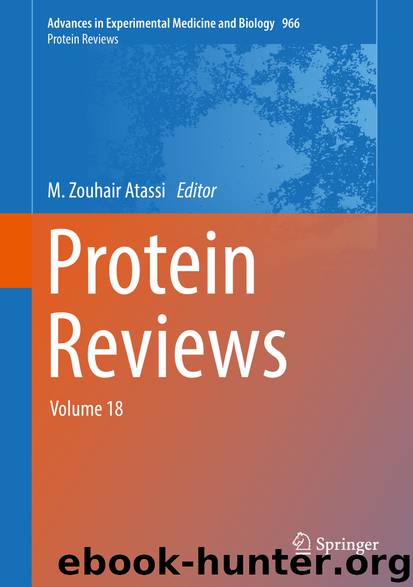Protein Reviews by M. Zouhair Atassi

Author:M. Zouhair Atassi
Language: eng
Format: epub
Publisher: Springer Singapore, Singapore
4 Conclusions and Perspectives
There are several indications suggesting that SERPINA5 is internalized by cells in a manner similar to that seen with cell penetrating peptides/proteins. However, so far there is no definitive proof for this assumption. The fact that internalization of a related heparin-binding serpin (SERPIND1, heparin cofactor II) was not observed under similar assay conditions does not justify the conclusion that the internalization is specific for SERPINA5. It can as well be a more general phenomenon seen with many proteins. Although several intracellular proteins interacting with SERPINA5 have been identified (Furtmüller et al. 2014) (Sokolikova et al., unpublished), it is not known if its internalization is biologically relevant. Further studies are needed to determine the intracellular functions of SERPINA5. So far all SERPINA5 internalization studies were done with cells growing in suspension (HL60 cell, Jurkat cells, and platelets). It is therefore also unclear if extracellular matrix components contribute to SERPINA5 internalization. In addition to exposed phospholipids and glycosaminoglycans on the cell surface, also substances in the vicinity of cells could influence SERPINA5 internalization either by causing local accumulation of the protein or by proteolytic removal of its N-terminal cell penetrating peptide. Further studies are needed to clearly define which features enable certain cells to internalize SERPINA5, while it is excluded from others. Such features could be the phospholipid composition of the cell membrane, the presence of surface exposed complex sugars, the transmembrane voltage potential, and/or cell-specific chaperone proteins or co-factors. The only in vivo data obtained so far are from experiments where labeled SERPINA5 was injected into the tail vein of mice. In these experiments Baumgärtner et al. have shown that injected SERPINA5 was detectable in the nucleus of peripheral blood granulocytes (Baumgartner et al. 2007). Therefore data obtained ex vivo with cells in suspension need to be confirmed with intact tissues and in the living organism. Thereby possible new ways of protein translocation could be identified which may be used not only by SERPINA5, but also by other proteins.
Download
This site does not store any files on its server. We only index and link to content provided by other sites. Please contact the content providers to delete copyright contents if any and email us, we'll remove relevant links or contents immediately.
| Automotive | Engineering |
| Transportation |
Whiskies Galore by Ian Buxton(41879)
Introduction to Aircraft Design (Cambridge Aerospace Series) by John P. Fielding(33064)
Small Unmanned Fixed-wing Aircraft Design by Andrew J. Keane Andras Sobester James P. Scanlan & András Sóbester & James P. Scanlan(32743)
Craft Beer for the Homebrewer by Michael Agnew(18140)
Turbulence by E. J. Noyes(7936)
The Complete Stick Figure Physics Tutorials by Allen Sarah(7307)
Kaplan MCAT General Chemistry Review by Kaplan(6867)
The Thirst by Nesbo Jo(6827)
Bad Blood by John Carreyrou(6552)
Modelling of Convective Heat and Mass Transfer in Rotating Flows by Igor V. Shevchuk(6391)
Learning SQL by Alan Beaulieu(6211)
Weapons of Math Destruction by Cathy O'Neil(6146)
Man-made Catastrophes and Risk Information Concealment by Dmitry Chernov & Didier Sornette(5921)
Digital Minimalism by Cal Newport;(5664)
Life 3.0: Being Human in the Age of Artificial Intelligence by Tegmark Max(5474)
iGen by Jean M. Twenge(5366)
Secrets of Antigravity Propulsion: Tesla, UFOs, and Classified Aerospace Technology by Ph.D. Paul A. Laviolette(5309)
Design of Trajectory Optimization Approach for Space Maneuver Vehicle Skip Entry Problems by Runqi Chai & Al Savvaris & Antonios Tsourdos & Senchun Chai(5011)
Pale Blue Dot by Carl Sagan(4912)
